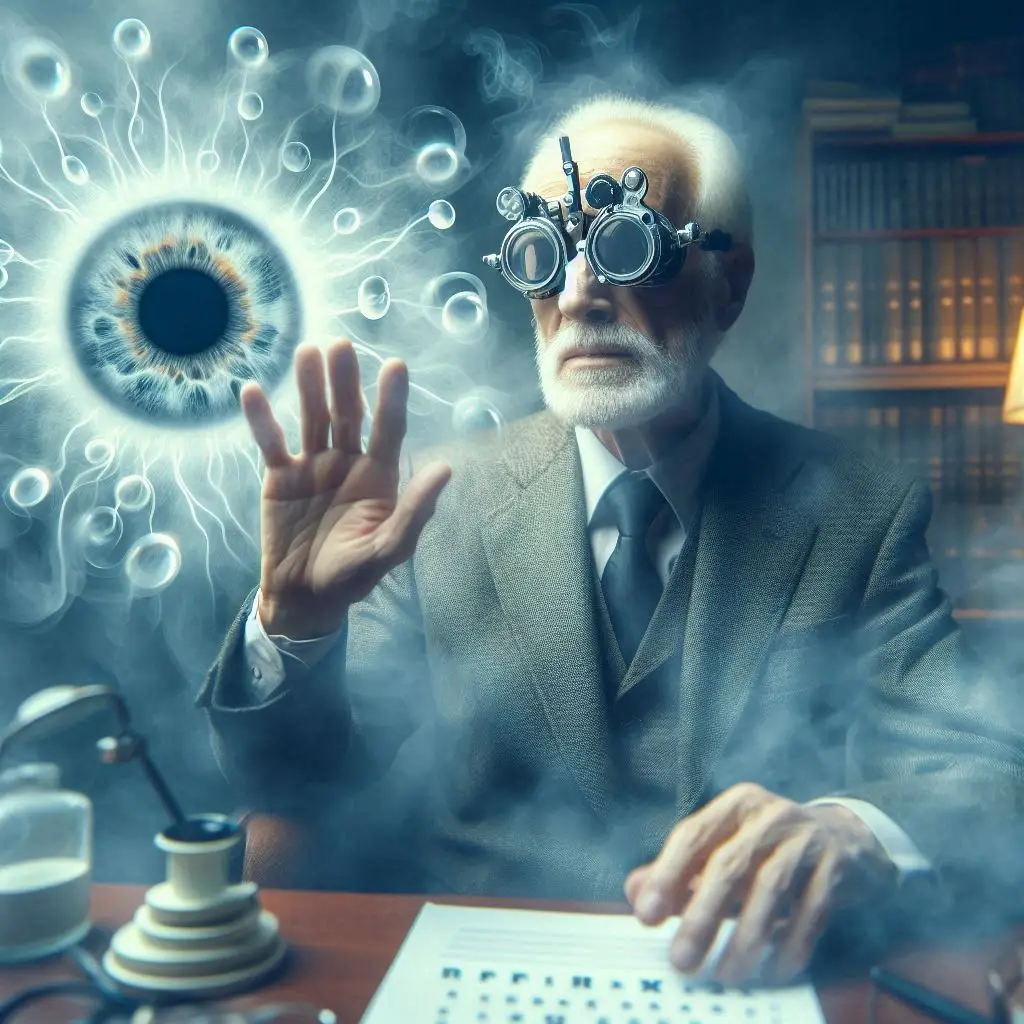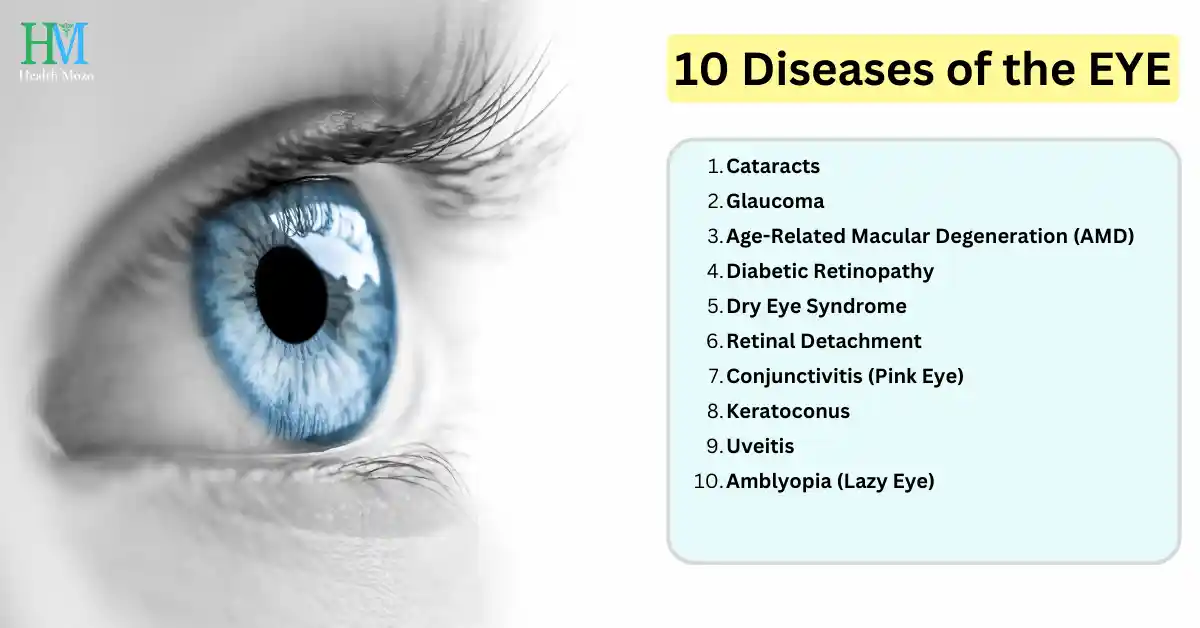Introduction
10 diseases of the eye: Your eyes are your windows to the world, so keeping them healthy is crucial. Eye diseases can sneak up on you, affecting your vision and quality of life. Let’s dive into the top 10 eye diseases you need to be aware of, their symptoms, causes, and treatment options.
Diseases of the Eye:
1-Cataracts
What are Cataracts?
Cataracts occur when the eye’s natural lens becomes cloudy, leading to impaired vision.
Imagine your eye is like a camera. The lens inside is clear, like the glass in a camera’s lens. It helps to focus light on the back of your eye, where it turns into pictures. But sometimes, the lens can become cloudy, like a foggy window. This is called a cataract.
When your lens is cloudy, it’s harder for light to get through, and your vision becomes blurry. It’s like trying to see the world through a misty windshield.
Causes of Cataracts
Aging is the primary cause, but other factors like diabetes, smoking, and prolonged UV exposure can contribute.
Key points (causes of cataracts):
- Aging: Most common cause of cataracts.
- Diabetes: This can increase the risk of developing cataracts.
- Smoking: Linked to a higher chance of cataracts.
- UV Exposure: Prolonged sun exposure can contribute to cataract formation.
Symptoms of Cataracts
- Blurred vision
- Difficulty seeing at night
- Sensitivity to light
- Seeing “halos” around lights
- Frequent changes in prescription glasses
Treatment Options for Cataracts
- Cataract surgery is highly effective.
- It involves replacing the cloudy lens with a clear artificial one.
- This procedure restores vision effectively.
2-Glaucoma
Understanding Glaucoma
- Glaucoma is a term for a group of eye conditions that can damage the optic nerve, the nerve that transmits visual information to the brain.
- A healthy optic nerve is important for good eye vision.
- In glaucoma, fluid buildup inside the eye can lead to increased pressure, which over time can damage the optic nerve and cause vision loss.

Types of Glaucoma
- Open-angle glaucoma
- Angle-closure glaucoma
Symptoms of Glaucoma
- Vision loss: This can manifest as patchy blind spots, either in your peripheral (side) vision or central vision.
- Tunnel vision in advanced stages
Treatment and Management of Glaucoma
- While there’s no cure for glaucoma, treatments can help control it and prevent further vision loss.
- These options include prescription eye drops, oral medications, laser treatment, or surgery.
- Early detection is crucial for successful management and preserving your sight.
3-Age-Related Macular Degeneration (AMD)
What is AMD?
Age-related macular degeneration (AMD) is a common eye disease that affects the macula, a small but vital area of the retina responsible for sharp, central vision. This allows us to see fine details, like reading, recognizing faces, and driving.
- Impact on Vision: AMD damages the macula, leading to a gradual decline in central vision. While it doesn’t cause complete blindness, it can significantly impact daily activities that require clear central sight.
- Leading Cause of Vision Loss: AMD is a leading cause of vision loss in older adults, especially those over 50. Early detection and management are crucial to slow its progression and preserve vision.
Risk Factors for AMD
- Age
- Family history
- Smoking
- High blood pressure
Symptoms of AMD
- Blurred or reduced central vision
- Difficulty recognizing faces
- Straight lines appearing wavy
Treatments for AMD
While there’s no cure, treatments like anti-VEGF injections, laser therapy, and dietary changes can slow progression.
4-Diabetic Retinopathy
Overview of Diabetic Retinopathy
Diabetic retinopathy is a serious eye condition that specifically affects people with diabetes. High blood sugar levels, a hallmark of diabetes, can damage the delicate blood vessels in the light-sensitive tissue at the back of the eye, known as the retina.
This damage can occur in several ways:
- Leaking Blood Vessels: Over time, high blood sugar weakens the blood vessel walls, causing them to leak fluid and blood into the retina. This leakage can distort vision and cause blurry sight.
- Blocked Blood Vessels: Chronically high blood sugar levels can also lead to the blockage of blood vessels in the retina. This restricts oxygen and nutrient flow to the retinal tissue, potentially leading to vision loss.
- Abnormal Blood Vessel Growth: In some cases, the body attempts to compensate for the blocked blood vessels by growing new, abnormal blood vessels on the surface of the retina. These fragile vessels are prone to bleeding, further jeopardizing vision.
How Diabetes Affects the Eyes
Chronic high blood sugar can block the tiny blood vessels that nourish the retina, leading to vision problems.
Symptoms of Diabetic Retinopathy
- Spots or dark strings in vision (floaters)
- Blurred vision
- Impaired color vision
- Dark or empty areas in vision
Managing Diabetic Retinopathy
Control your blood sugar, blood pressure, and cholesterol. Laser surgery and vitrectomy are treatment options.
5-Dry Eye Syndrome
What is Dry Eye Syndrome?
Dry eye syndrome is a common condition that happens when your eyes’ natural lubrication system, the tear film, gets disrupted. This tear film is a delicate, three-layered structure, and each layer plays a crucial role. It’s essential to understand and address this condition with care, as it can greatly affect your comfort and quality of life.
- Oil Layer: The outermost oily layer helps prevent tears from evaporating too quickly, keeping the eyes moist.
- Watery Layer: The middle watery layer makes up the bulk of the tear film and helps to flush away dust and debris, keeping the eyes clean.
- Mucus Layer: The innermost mucus layer helps the watery layer spread evenly over the surface of the eye, providing a smooth and clear visual surface.
In dry eye syndrome, there can be two main issues:
- Tear Deficiency: The lacrimal glands, responsible for tear production, may not produce enough tears. This can be due to various factors like aging, underlying medical conditions, or medications.
- Rapid Tear Evaporation: Even with adequate tear production, the tears may evaporate too quickly. This can occur due to environmental factors like dry air, wind, or increased screen time.
This disruption in the tear film leads to a variety of uncomfortable symptoms and can potentially affect vision if left unaddressed.
Causes of Dry Eye Syndrome
- Aging
- Medication side effects
- Medical conditions
- Environmental factors
Symptoms of Dry Eye Syndrome
- Stinging or burning sensation
- Redness in the eyes
- Sensitivity to light
- Eye fatigue
Remedies and Treatments
Use artificial tears, prescription eye drops, and lifestyle changes like taking breaks from screen time.
- Symptom Relief: Use artificial tears or prescription eye drops to soothe irritated eyes.
- Lifestyle Adjustments: Reduce eye strain by taking breaks from screens and ensuring proper lighting.
- Vision Correction: Update your glasses prescription to improve vision clarity.
- Surgical Intervention: In advanced cases, cataract surgery may be necessary to restore clear vision.
6-Retinal Detachment
Understanding Retinal Detachment
This serious condition occurs when the retina peels away from its underlying layer of support tissue.
Causes of Retinal Detachment
- Aging
- Severe myopia (nearsightedness)
- Eye injuries
Symptoms to Watch For
- The sudden appearance of floaters
- Flashes of light
- Vision Blockage: This can manifest as a shadow or dark curtain obscuring a part of your field of vision. This area of blockage can appear in various locations, like the periphery (side) or central vision, and may come on suddenly or develop gradually.
Treatment Options
Surgery is almost always required to reattach the retina. Timely intervention is critical.
7-Conjunctivitis (Pink Eye)
What is Conjunctivitis?
Conjunctivitis, or pink eye, is the inflammation or infection of the conjunctiva, the thin, clear tissue that lies over the white part of the eye and inside the eyelid.
Types of Conjunctivitis
- Viral conjunctivitis
- Bacterial conjunctivitis
- Allergic conjunctivitis
Symptoms of Conjunctivitis
- Redness in one or both eyes
- Itchiness in one or both eyes
- A gritty feeling
- Discharge from the eyes
Treatment and Prevention
Depending on the type, it can be treated with antibiotics, antiviral medication, or allergy medications. Good hygiene can prevent its spread.
8-Keratoconus
What is Keratoconus?
Keratoconus occurs when the cornea thins and gradually bulges outward into a cone shape, distorting vision.
Causes and Risk Factors
- Genetic predisposition
- Excessive eye rubbing
- Certain eye diseases
Symptoms of Keratoconus
- Blurred or distorted vision
- Increased sensitivity to light
- Frequent changes in eyeglass prescriptions
Treatment and Management
Treatment options include glasses, contact lenses, or in advanced cases, corneal cross-linking or corneal transplant.
9-Uveitis
Understanding Uveitis
Uveitis is inflammation of the uvea, the middle layer of the eye, which can cause swelling and destroy eye tissues.
Causes of Uveitis
- Infections
- Autoimmune diseases
- Injuries
- Toxins
Symptoms of Uveitis
- Eye redness
- Pain
- Blurred vision
- Light sensitivity
Treatment Options
- Medication: Steroids and other anti-inflammatory medications to reduce inflammation.
- Long-Term Care: Identifying and treating the underlying cause is crucial for long-term management.
10-Amblyopia (Lazy Eye)
What is Amblyopia?
Amblyopia, often called lazy eye, is a vision condition where one eye doesn’t develop proper eyesight. It’s a challenging issue, as it means that the eye struggles to see clearly, which can affect daily activities and overall quality of life. It’s important to address it with care and attention to help improve vision and support overall well-being.
Key Points: Amblyopia (Lazy Eye)
- Vision Condition: One eye doesn’t develop normal eyesight.
- Impact: Difficulty seeing clearly, affecting daily life and overall well-being.
- Importance: Early detection and treatment are crucial for vision improvement.
- Care: This requires careful attention and appropriate treatment.
Causes of Amblyopia
- Strabismus (misaligned eyes)
- Refractive errors
- Cataracts
Symptoms of Amblyopia
- Poor depth perception
- Squinting or shutting an eye
- Head tilting
Treatment Options
Treatments include corrective eyewear, eye patches, and sometimes surgery to correct the underlying cause.
Conclusion
Our eyes are our window to the world, playing a vital role in how we experience and navigate our surroundings. Maintaining good eye health is essential not just for clear vision but also for overall well-being.
Regular eye check-ups are crucial for early detection of eye diseases like glaucoma, macular degeneration, and diabetic retinopathy. Early diagnosis allows for prompt treatment, significantly improving the chances of successful management and preserving vision. Don’t wait until you experience vision problems – prioritize your eye health and schedule a comprehensive eye exam today!
FAQs
What are the first signs of eye disease?
The first signs often include blurred vision, floaters, and difficulty seeing at night. If you notice any changes in your vision, see an eye doctor promptly.
How can I protect my eyes from disease?
Regular eye exams, wearing sunglasses, maintaining a healthy diet, and avoiding smoking can protect your eyes.
Are all eye diseases treatable?
While not all eye diseases are curable, many are treatable with early detection and proper management.
Can lifestyle changes improve eye health?
Yes, healthy habits like a balanced diet rich in omega-3 fatty acids, regular exercise, and avoiding smoking can significantly improve eye health.
When should I see an eye doctor?
You should see an eye doctor if you experience any sudden changes in vision, eye pain, or other concerning symptoms. Regular check-ups are also recommended.


2 thoughts on “10 Diseases of the Eye You Need to Know About and Prevent”